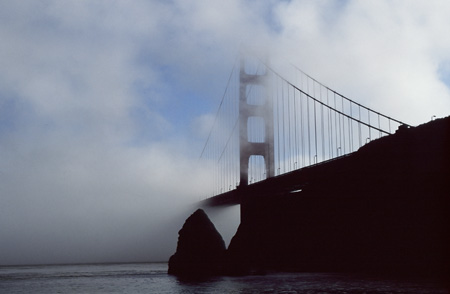|
Reviews of Recent Independent, Foreign, & Documentary Films in Theaters and DVD/Home Video
Directed & Produced by: Eric Steel. Director of Photography: Peter McCandless. Edited by: Sabine Krayenbuhl. Music by: Alex Heffes. Released by: First Stripe Productions. Country of Origin: USA. 93 min. Rated R. This documentary is not about the Golden Gate Bridge. It is a clear-eyed gaze at suicide in which debut director Eric Steel examines one particularly public method. The first jump off the bridge in broad daylight he records is no easier to watch than the last. Inspired by Tad Friend’s New Yorker article, “Jumpers: The Fatal Grandeur of the Golden Gate Bridge,” Steel documents the 24 jumpers in 2004, an average year, and interviews the family and friends that seven mostly young adults left behind. One refers to a family history of alcoholism, another to a failed romance, and a distraught and deterred jumper mentions crystal meth use. The overwhelming picture is one of the frankest portraits of mental illness and the limits of medication and control since The Devil and Daniel Johnston. The biographical interviews and final day reconstructions are poignant. While a brother is still in denial even as we witness his sister’s leap, most were not surprised by what they almost all call a choice. However, I am not sure this ineffably sad film will further help other suffering families work through their continuing agony, as so many are torn apart in the wake of such devastation. Intercut throughout are recurring images during a picture-perfect day of one longhaired young man, Gene, who Steel happened to track for 90 minutes as part of his goal to film the bridge during every daylight hour for one year. Gene’s friends talk in detail about his life and black moods, so we know in explicit detail what is about to happen as he walks back and forth. Yet, it is still startlingly tragic when the camera catches his final moments. Peter McCandless’ beautiful cinematography, seen to best advantage on a theatrical screen, captures the breathtaking bridge from sunrise to sunset, a locus for tourists and recreation – kite boarders, joggers, and the many people who stroll over the bridge and are memorably haunted by suddenly facing a jumper in their midst. It will be difficult to see photos of the bridge in the future without recalling these images. We observe individuals transfixed by the water, and we can’t help but try to guess with alarm, along with the camera operator who would alert the bridge patrol, which one is just lost in the idyll and which one is about to jump. The sylvan atmosphere around the bridge’s soaring glory is shattered over and over again by the horror of people jumping off and descending in four seconds into the water, almost identical to the images that the media have considered too sensitive to show in fiction or documentaries about the World Trade Center conflagration, personally witnessed by the filmmaker. Sometimes we just hear the dreadful plop as they land in the water. There is visceral relief at the occasional intervention, clothes grabbed in the nick of time or another talked off the ledge. It is even more startling to hear a lengthy interview with a survivor (as of 2003 there have been only 26). He had an immediate change of heart after letting go of the railing, repositioning himself feet first. His experiences with bipolar disorder are buttressed by his father’s recollection of what the family has tried to do over the years, even on that fateful day, and just how difficult the struggle to deal with his son’s depression continues to be.
Without any narration or explanation and only a few statistics before the final credits, the revelations of the passive cameras,
one set at a static wide angle and another roaming with a telephoto lens, make clear that despite the bridge’s iconic image and
standing as the world's suicide magnet since its opening in 1937, more could be done on a practical level to make jumping more
difficult than just simply stepping over a low railing, such as have been successfully installed at other landmarks like the
Empire State Building. (Over 1,000 people
have jumped to their deaths from the bridge.) Since its showings at festivals, the film has already spurred administrators to again study
barriers. Though most of the interviewees feel their loved one would have committed suicide anyway, experts Friend interviewed
challenged that assumption. This moving film should spur further discussion of the serious public health issue of suicide prevention and intervention.
Nora Lee Mandel
|

